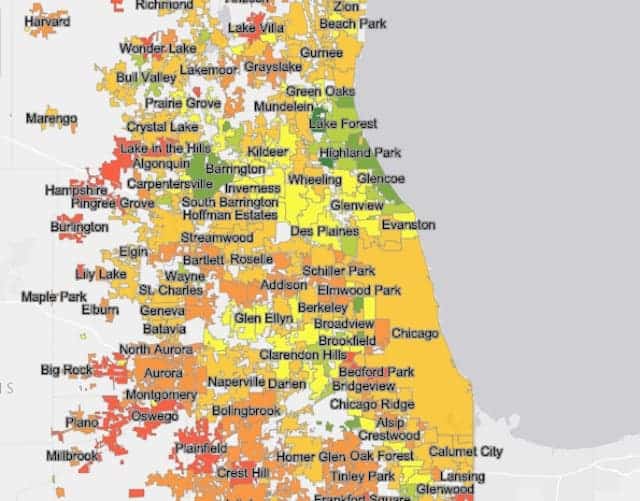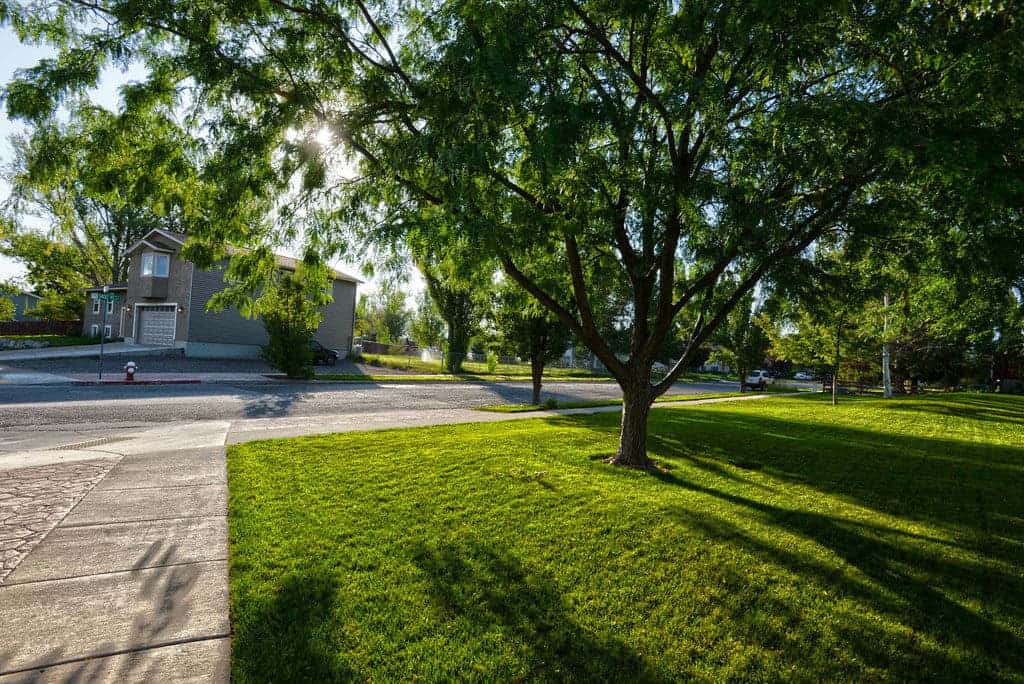The most comprehensive tree canopy data set of any region in the U.S. reveals many interesting things, including a startling correlation. Whenever trees go up, crime goes down.

A tree with fruit
The Chicago Region Tree Initiative and Morton Arboretum overlaid a wide variety of data to come up with an extremely detailed interactive map. They combined results with LIDAR imagery, a surveying method that measures distance to a target using a pulse laser. This allowed them to map canopy coverage in great detail.
But creating the map was only the first step. They then started to correlate it with demographic information and look for patterns.
“We’re able to layer heat island data; demographic information such as age, vulnerable population, education background; we’re layering Medicaid claims because we know there’s a correlation between health issues—cardiopulmonary problems—and loss of trees,” says Lydia Scott, director of the Chicago Region Trees Initiative (CRTI).

Indeed, the benefits of trees in urban areas have long been discussed. Not only do they stabilize water circulation and prevent soil erosion, but they’re also good for our health. They can capture up to half of the particulate pollution in the air, reduce the risk of cardiovascular diseases and diabetes, and help with our mental health.
They were expecting to find such correlations, which they did, but they also found something they weren’t expecting.
The root of crime
Chicago is not really what you would call a peaceful city. The city’s crime rate is substantially higher than the country average, being responsible for nearly half of 2016’s increase in homicides in the US. It’s not yet clear what causes this unusual criminality, and it’s not yet clear how the problem can be solved. But to some extent, trees seem to help.
“We started to look at where we have heavy crime, and whether there was a correlation with tree canopy, and often, there is,” says Scott. “Communities that have higher tree population have lower crime. Areas where trees are prevalent, people tend to be outside, mingling, enjoying their community.”

Chicago’s richest and safest areas tend to have high canopy covers, up to 40 percent. Meanwhile, on the economically depressed South Side, canopy cover can be as low as 7 percent. The map seemed to show, time after time, that areas with rich canopies are safer, and the ones with high criminality are “tree deserts.”
It seems like a strange idea to digest.
“When we go to talk to communities,” says Lydia Scott, “We say ‘trees reduce crime.’ And then they go, ‘Explain to me how that could possibly be, because that’s the most bizarre thing I’ve ever heard.’”
As Atlas Obscura also points out, it seems like one of those “correlation, not causation” things — and this also makes a lot of sense. Poorer neighborhoods see fewer investments and less taking-care-of, so it might be that poorer neighborhoods, which often have high crime rates, just tend to have fewer trees. In other words, criminality and a lack of trees may not be cause and effect but may have a common cause.
However, Scott and colleagues point out to a number of studies indicating the benefits of urban trees, including several which discuss mental benefits. Among those studies, one suggests that trees “may deter crime both by increasing informal surveillance and by mitigating some of the psychological precursors to violence.”
Help the trees help us

Scott immediately met with the mayor to present their findings and encourage the municipality to start planting more trees strategically — in areas that need them most. Of course, it will take a long time before the benefits are truly reaped, but even in the short term, trees can help communities. They help with both flooding and droughts, they improve property values, provide shelter against the heat and promote feelings of safety.
But, as Blacks in Green, a Chicago-based economic development organization which aims to create self-sustaining black communities through green initiatives learned, trees can do so much more for a community.
“We’re using the green economy to galvanize, organize, energize,” founder Naomi Davis told Atlas Obscura. Davis has met with Scott and CRTI multiple times over the last few years in order to plan BiG’s approach. “When you’re starting something, you should take stock of what you got,” Davis says. “We realized we were going to need to start with a tree inventory. Now we’re finally getting that inventory.”
To make this point, BiG started buying lots from the city (for $1). They’ve created a charming little orchard, with plum, crabapple, and pawpaw trees.
“We are looking at what it would mean to have a green, healthy space in a blighted African-American neighborhood…We have a really nasty, barren, burnt out commercial corridor, which is 61st Street. Last year we planted about 45 trees there.”
When people work to plant or maintain such green spaces, they’re bonding and creating a sense of community, which also helps reduce crime. It could also help people learn a new skill which could land them a job.
“This is something that is a strong career for good-paying wages,” Davis says. “We’re gonna need more trees than ever to be planted because of climate change.” BiG will have a horticulturalist career fair in October. “In a neighborhood where unemployment is so high,” she says, it’s a game-changer.
It’s hard to say exactly how and exactly how much, but it seems clearer and clearer that trees prevent a stunning number of benefits, especially in urban settings. But they’re also at risk, due to invasive species, improper caring, and rising temperatures. Hopefully, municipalities and policy makers will understand these aspects and


